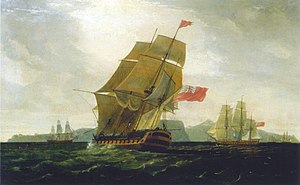HMS Diadem (1782)
 Diadem at the capture of the Cape of Good Hope (Thomas Whitcombe)
| |
| History | |
|---|---|
| Name | HMS Diadem |
| Ordered | 5 December 1777 |
| Builder | Chatham Dockyard |
| Laid down | 2 November 1778 |
| Launched | 19 December 1782 |
| Commissioned | March 1783 |
| Honours and awards |
|
| Fate | Broken up at Plymouth, September 1832 |
| General characteristics [2] | |
| Class and type | Template:Sclass- |
| Tons burthen | 1375½ bm |
| Length | 159 ft 10 in (48.72 m) (gundeck) |
| Beam | 44 ft 5 in (13.54 m) |
| Depth of hold | 19 ft (5.8 m) |
| Propulsion | Sails |
| Sail plan | Full rigged ship |
| Complement | 500 |
| Armament | |
HMS Diadem was a 64-gun third rate ship of the line of the Royal Navy, launched on 19 December 1782 at Chatham.[2] She participated in the Battle of Cape St Vincent in 1797 under Captain George Henry Towry.
In 1798 she was converted to serve as a troopship.[2] On 7 April 1799 she left Portsmouth together with Trompe. They were carry the West York militia to Dublin.[3]
In 1800 under the command of Post Captain Sir Thomas Livingstone she was employed in the expedition to Quiberon and Belle Île under Sir Edward Pellew, subsequently she was employed in the expedition to Cádiz under Admiral Lord Keith.
Because Diadem served in the navy's Egyptian campaign between 8 March 1801 and 2 September, her officers and crew qualified for the clasp "Egypt" to the Naval General Service Medal that the Admiralty authorised in 1850 to all surviving claimants.[Note 1]
Between April and July 1810 Diadem was at Chatham being fitted for service as a troopship of 28 guns. In June Captain John Phillimore (or Philmore) commissioned her for Lisbon.[5] She then spent some time working with the Spanish anti-French forces on the north coast of Spain.[6] In January 1812 she carried released Danish prisoners of war from Plymouth to Chatham.
On 7 October Diadem captured the American letter of marque Baltimore.
Later, she sailed to the Halifax station.[5] Phillimore transferred to command of HMS Eurotas on 4 May 1813.[7]
Fate
Diadem was broken up in September 1832.[2]
Notes and citations
- Notes
- Citations
- ^ "No. 21077". The London Gazette. 15 March 1850. pp. 791–792.
- ^ a b c d Lavery, Ships of the Line, vol. 1, p. 181.
- ^ Naval Chronicle, Vol. 1, p.444.
- ^ "No. 17915". The London Gazette. 3 April 1823. p. 633.
- ^ a b Winfield (2008), pp.99-100.
- ^ O'Byrne 1849), Vol. 1, p.306.
- ^ Marshall (1827), Supplement, Part 1, p.245,
References
- Lavery, Brian (2003) The Ship of the Line - Volume 1: The development of the battlefleet 1650-1850. Conway Maritime Press. ISBN 0-85177-252-8.
- Lyon, David (1993) The Sailing Navy List. Conway Maritime Press. ISBN 0-85177-617-5.
- Leask, David (2008) Website on the History of Westquarter
- Marshall, John (1823–1835). Royal naval biography, or, Memoirs of the services of all the flag-officers, superannuated rear-admirals, retired-captains, post-captains, and commanders, whose names appeared on the Admiralty list of sea officers at the commencement of the present year 1823, or who have since been promoted ... London: Longman, Hurst, Rees, Orme and Brown.
- O’Byrne, William R. (1849) A naval biographical dictionary: comprising the life and services of every living officer in Her Majesty's navy, from the rank of admiral of the fleet to that of lieutenant, inclusive. (London: J. Murray), vol. 1.
- Winfield, Rif (2008). British Warships in the Age of Sail 1793–1817: Design, Construction, Careers and Fates. Seaforth. ISBN 1-86176-246-1.
